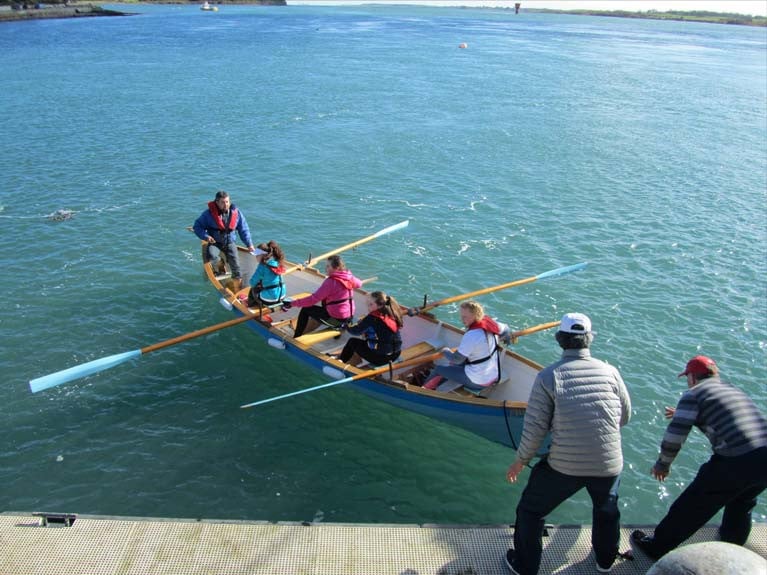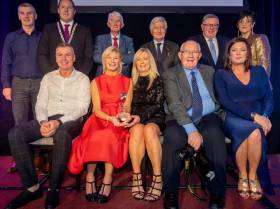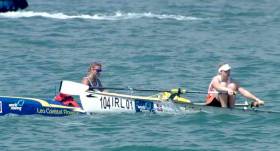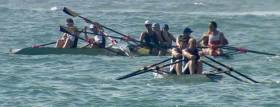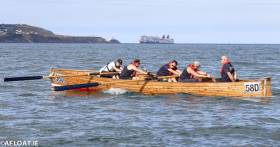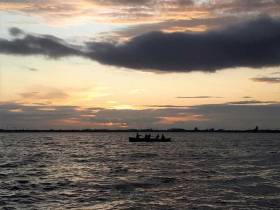Displaying items by tag: Coastal Rowing
With 22km winds howling around Cork Harbour last Saturday morning, the Ocean to City team should have been in a frenzy reorganising the race routes, but instead, they were online in the middle of launching their Ocean to City Virtual Challenge. From the comfort of their homes the organisers did a countdown for over a hundred participants, from all over the world, who were getting ready to row Ocean to City on their rowing machines.
At 10.30 am the Zoom screens were filled with participants from Ireland, UK, Portugal, USA, Australia, Germany and Lebanon. Race Director Donagh MacArtain began the event talking about the difficult decision to cancel this year’s race and thanking those who supported and continue to support the Cork Harbour Festival: Cork City Council, Cork County Council, Port of Cork, Fáilte Ireland and many more who have ensured the future of the festival and Ocean to City. Lord Mayor of Cork City, Cllr. John Sheehan joined in the Zoom meeting to formally welcome all participants. The Lord Mayor spoke on the importance of a collective in these strange times and how vital it is to bring people together. He remembered starting his term as Lord Mayor launching the Lee Swim and how apt it was to finish it with the Ocean to City.
The event had two categories to choose from, the Rowing Machine Challenge – where participants rowed the equivalent time to either the Ocean Course (2hr23min39sec) or the Monkstown Course (1hr1mins12secs). The furthest distance rowed within the time limit would win. The second category was the Fun Time challenge – where participants had to record their most creative rowing or paddling training on land. The event was also joined by UK runner Lawrence Washington who ran for the full Ocean Course time limit, from his home to the town of Porthmadog and back.
The race began at 11am and stayed live on Facebook and Zoom where spectators could watch the efforts of the participants in the rowing challenge. Along with the rowing challenge, participants were asked to send in videos of their creative home training and the submissions were fantastic! All submitted videos are available on oceantocity.com along with the full results on the day.
The 16th Ocean to City was a very different day but thankfully the day and the ethos of this wonderful race was marked, as a community of like-minded people who have a love of the water, of Cork and the spirit to adapt to new circumstances.
Ocean to City – An Rás Mór, the flagship event of Cork Harbour Festival is organised by Meitheal Mara, the community boatyard, training centre and charity located in the heart of Cork City. The event is sponsored by Cork City Council, Cork County Council, Port of Cork, Fáilte Ireland and made possible with the help of dozens of Event Partners and hundreds of volunteers.
Cork Harbour Festival will be back next year 5-13 June 2021 with the flagship Ocean to City – An Rás Mór taking place on Saturday 5 June 2021.
Portmagee Leads Coastal Rowing Clubs Back to the Water
Portmagee Rowing Club was one of the first coastal rowing clubs in Ireland back on the water on Monday morning. The restrictions were lifted to allow single sculling to begin while using set precautions and observing distancing. Portmagee owns a coastal single scull and the junior members were delighted to be back in action. Portmagee owns several sets of new oars which were purchased under the sports grants last year thus allowing each member to use one specific set preventing cross-contamination and the scull is wiped down with sanitiser after each session. Water, soap and sanitizers are also available at the slip where training takes place.
Portmagee crews usually train on the rowing machines and do gym work during the winter and then move into the crew boats as the weather improves in the spring. Speaking to the athletes at training today, Aoife Murphy (who is also the club PRO) said that it’s been nine weeks since they were last on the water. She found it difficult to keep training at home on the erg and doing circuits as its hard to train on your own, but now is delighted to have all that work done for the coming season. She found a routine at home that allowed her to train daily and is looking forward to the highlight of the season, the Irish Coastal Rowing Championships, later on in the year. She feels that training will be more intense due to the shorter season and is really looking forward to it.
Jane O’Connor found no difficulty getting back into the boat after a nine-week layoff. She also found it hard to remain motivated training on your own as opposed to group training. She finds crew rowing better as you push yourself more during training with others and is also looking forward to the National Championships.
Also during a conversation with our neighbours, Cahersiveen Rowing Club this morning, they revealed that they are preparing to get back on the water with their junior crews in the coming weeks. Cahersiveen has always been recognised as a proud, traditional club that is very passionate about preserving the traditions of our sport for future generations. They have done a massive refurbishment job this winter on their seine boat, the Liberator. The Liberator was built in 1969 by the legendary boat builder, Johnny Mahony of Ardcost, and has been winning races ever since. With a crew ready to go and a boat nearly ready, here’s another club only delighted to be finally able to get back on the water.
Coastal Rowing in Northern Ireland Revival Continues
County Down has become an important centre for coastal rowing with clubs dotted around Strangford Lough and the Ards Peninsula. This is very much a community-based activity with skiffs active at Strangford, Portaferry, Portavogie, Donaghadee, Dundrum, Killyleagh, Sketrick, Strangford, and Kircubbin. There is also rowing at Ardglass and Ballywalter.
Down Coastal Rowing Association was set up in 2014 by the Strangford Lough and Lecale Partnership (SLLP) working with the PSNI to revive traditional boatbuilding and coastal rowing as part of a wider effort to regenerate communities through their maritime heritage. It was approved by the Down Rural Area Partnership (DRAP) as part of the European Agricultural Fund for Rural Development: Europe investing in rural areas, supported by the Northern Ireland Environment Agency, and Down District and Ards Borough Councils.
This revival of an old sport has been a phenomenal success with community boats built, virtually all St Ayles skiffs, and clubs established. The St Ayles class has spread very quickly with numbers growing all the time. A key player in the construction of the boats is Jeremy Duffin of Strangford.
 Northern Ireland coastal rowing
Northern Ireland coastal rowing
Strangers become friends and teamworking has forged relationships across and between communities. There is also healthy competition and each community holds training and competitive activities all year round.
"Teamwork has forged relationships across and between communities"
The rowing has also brought people into contact with the area's landscape and wildlife and they, in turn, have helped to look after it, taking care not to disturb seals and birds and taking part in shore clean-ups. This is important because Strangford Lough is an Area of Special Scientific Importance.
The World Championships, (Skiffie Worlds) were held in Strangford Lough in 2016, hosted by Strangford Lough & Lecale Partnership (SLLP) working closely with the Scottish Coastal Rowing Association (SCRA), and with the support of local councils and communities along the County Down Coast. Last year Stranraer hosted the World Championships in which the Dundrum team were the overall winners.
St. Patrick’s Rowing Club Scoops National Award in Kilkenny
St. Patrick’s Rowing Club Ringsend has received a national IPB Pride of Place award for their commitment to the community.
The 17th Annual All-Ireland Pride of Place Gala Awards Ceremony was held in the Lyrath Hotel in Kilkenny last Saturday night the 30th November 2019.
The purpose of the IPB competition is to acknowledge the work being done every day by communities all over the island of Ireland. Since the competition commenced the IPB judges
have met hundreds of thousands of people, all of whom are proud of their place. St Patrick’s Rowing Club won the best Urban Neighbourhood project in an area with a population of
between 1,000 – 2,000 category.
The judges were particularly impressed with St. Patrick’s Rowing Club with its role as a “key community energiser in their area, which actively involves community, influences well-being and cares for the vulnerable in its area.”
Eimear McCormack Public Relations Officer for St. Patrick’s Rowing Club said: “This award showcases our club at a national level and credits those who volunteer to keep our club
going year on year”. She went on to say “however, we can’t forget past members to laid the foundations of the club and set the community ethos of the club we are today. This is a
fantastic achievement and one we will celebrate for a long time”.
St. Patrick’s Rowing Club is no stranger to awards, last year the club won “Dublin’s Best Sports Club” awarded by the listeners of 98FM and this year they were highly commended
by Dublin City Council for the upkeep of their club area.
World Coastal Rowing Championships Highlights Video from Hong Kong
The World Coastal Rowing Championships were a big success.
The Hong Kong sights provided a spectacular backdrop for a huge event. Ireland sent a big team, with multiple A Finalists, five in the solo women’s class: our top two, Sionna Healy of Arklow and Miriam Sheehan of Castletownbere, placed seventh and eighth.
Here are some striking images which recall this memorable occasion:
St. Michael's Rowing Club Compete for the First Time at World Coastal Rowing Championships
Two rowers from the St. Michael’s Rowing Club Dún Laoghaire, Colm Crily and Martin Dowd, qualified for and participated in the World Coastal Rowing Championships, which took place from the 1st to the 4th of November in Hong Kong. This is the first time that rowers representing the club participated in a World Championship. They competed in a coastal double scull (CMx2).
The team faced a difficult qualifying heat on the first day, Friday, when they rowed a 4,000m course consisting of 5 turning points, as they had to deal with an unexpected hand injury, but they managed to qualify for the Final B on Saturday, where they placed 14th.
‘Participating in the Worlds was an amazing experience for the team, as we were venturing into uncharted territory for us.’ said Colm Crilly.
 Colm Crily and Martin Dowd, qualified for and participated in the World Coastal Rowing Championships
Colm Crily and Martin Dowd, qualified for and participated in the World Coastal Rowing Championships
‘It was a tough competition, but we are proud to have represented the club and worn the colours. Thank you to everyone for their support,’ said Martin Dowd.
The St. Michael’s Rowing Club has so far promoted traditional East Coast clinker built skiff rowing, building on the heritage of the hobblers of old. Having two rowers compete in a men’s double coastal scull is an exciting beginning for the club, which is currently looking to expand its current fleet of 6 skiffs and a One Design boat to include a Celtic Longboat.
‘This is a great feat for the team. The club is delighted and proud of what they achieved.’ said Gary Bryne, St. Michael’s Captain. ‘We would like to thank the organisers, Rowing Ireland and Irish Offshore Rowing for their efforts in promoting this wonderful sport.’
#Rowing: Ireland will send a big team to the World Coastal Rowing Championships in Hong Kong early next month (November 1st to 3rd). Coastal Rowing is growing and may become part of the Olympic programme.
Niall O’Toole (49) was Ireland’s first world rowing champion. The three-time Olympian now runs Crew Class for indoor rowers. He tried his luck at the Irish Offshore Rowing Championships in September in Co Antrim. Here are his impressions.
The Rock’n Roll of Offshore Rowing
By Niall O’Toole
I was excited for my first offshore race. Rounding the corner, I arrived at the location to big breaking waves crashing onto the shoreline. I immediately knew this was something different: it was going to be ugly and unpredictable.
I fully hoped that the regatta would be called off, due to the extreme weather conditions. I looked to other competitors for solace. Instead of being able to gauge their fear, I was met with wide grins and a crazy glint in their eyes: they were unfazed. This was their normal. They were just looking forward to getting amongst it.
I’m used to something different. A sterile environment in your own lane, as fast as you can row from A to B over 2km. You train for your own race, your pace and pushes planned down to a T. You have very little to think about on the day, other than executing that race plan. A starter holds your stern, everyone in line, traffic lights signal the off. It’s all inch-perfect and highly controlled. You may have one or two glances out of the boat, but essentially you row without interference from others.
In Olympic-style rowing, we are guarded from the elements. Most international courses are strategically located to have a prevailing wind in one direction to avoid rough water. If there is wind, the water tends not to be affected. I wasn’t used to nature writing the rules.
There was a delay to racing due to a late change of course. We were told that it was no longer safe for the safety boats, and that rowers were likely to be pushed onto the rocks. When the officials said, “You need to ask yourself, is it safe for you to row today?” the answer was screaming in my head. The organisers said they’d run the first race and would review whether they would continue the regatta after that. I took this to mean that the first race competitors were now officially the canaries down the mine. They got around, despite buoys moving during the race, and the regatta continued, to my growing fear and dismay.
Shouldered with the weight of some rowing heritage behind me, I had to harness my dwindling toughness and get out onto the water, launching amidst breaking waves on the beach. Within 30 seconds I was completely soaked and instantly thought we needed a bigger boat.
The race starts with a floating start and is the only real part that you can plan. There are no individual lanes, just a fight for the best line around a 4km course of buoys. Your only real hope is to fly out the start and get clear of the field down to that all important first buoy, before traffic starts hitting you and rowing becomes a contact sport.
Battling the elements, and trying to keep the boat straight without a tiller was absolutely exhausting. Given my experience, I went out high and hard, but found it difficult to factor in the added dimensions of staying away from other boats and staying on the right lines to hit the markers. Trying to keep the boat straight against a crushing side-wind completely seized up my forearm within minutes of the start. Within the washing machine of the wind and waves, and the physical exertion of breathing through your ears, you are punished for small navigational mistakes which are big errors, handing away hard-fought lengths to more savvy and seasoned competitors.
I did enjoy it though, despite myself. The rush of adrenaline you get flying around buoys, fighting for your line, with other boats breathing down your neck. You are completely focused on getting in and out of the turn as quickly as possible, whilst also paranoid that your competitor is taking a better line, for reasons as yet unknown to you. The sheer volume of data you have to integrate along with the physical exertion maxed me out in a way I couldn’t have imagined.
This is one hell of a sport. Chaotic, unpredictable and exhilarating. It really is the rock’n roll of rowing. I’m completely hooked.
Niall O’Toole was part of the winning men’s quadruple, a composite crew of Wicklow, Kilurin and Ring, at the Irish Offshore Championships.
St. Michael's Coastal Rowing Club Raise €9k for RNLI
The St. Michael’s Rowing Club in Dún Laoghaire raised €9,289.80 for the RNLI as part of their fundraising effort for the Celtic Challenge, which they completed in May 2019.
Two crews from the St. Michael’s club entered the Challenge, a mixed crew rowing in a skiff and a ladies crew in a Celtic longboat in a 160km race across the Irish Sea, from Arklow to Aberystwyth.
The cheque was presented to RNLI representatives at the beginning of the week. The club has been taking part in the Celtic Challenge since 1997 and raising funds for various
charities, but this is the highest amount raised so far.
“ The Celtic Challenge is not just about proving the endurance of a team while crossing the Irish Sea, but it is also about how that team dedicates time, energy and passion to support a worthy cause. And we have proven that the Michaels are a great team in that respect as well ,” said Cathy Brooks, who completed the Challenge this year for the first time.
The St. Michael’s Club wishes to thank their sponsors: Newstalk, Morton Coaches, Jones Engineering, The Graduate, Healthy Ireland for their support, as well as everybody who donated for their generosity.
“ We are grateful to all our sponsors, families, friends, work colleagues and supporters who donated and helped us raise these funds for the RNLI and the amazing service they provide,” said Vincent Scully, Fundraising Coordinator for the event for the St. Michael’s Club
St. Michael’s Rowing Club hosted The Hobblers Coastal Rowing Challenge on Saturday, a 28km endurance race, which has been taking place since the 1990s on Dublin Bay.
Several courses have been used, predominantly from Dún Laoghaire Harbour to the Kish Lighthouse and back.
As Afloat previously reported, four categories competed this year: Ladies, Men, Mixed and Under 21.
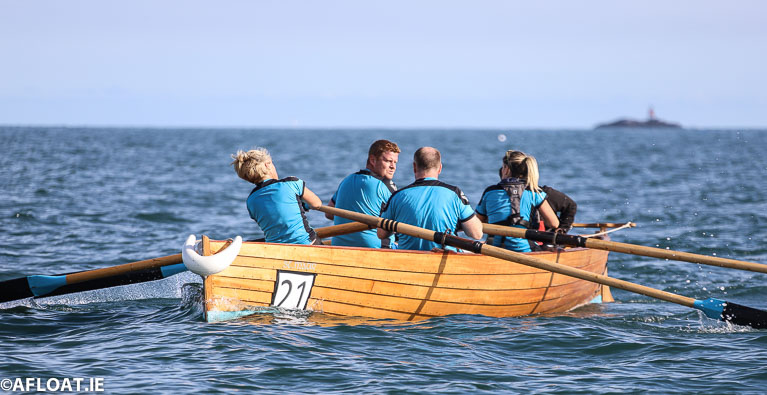
Saturday's course, first set in 2017, started at Dun Laoghaire Harbour, at the East Breakwater beneath the Hobblers Memorial, out the harbour mouth, around the landward side of a ‘gate boat’ off Merrion Strand, around Poolbeg Lighthouse, up the Liffey as far as the ESB towers, before doubling back, across the mouth of Dun Laoghaire Harbour, across Scotsman’s Bay, past Sandycove and Bullock Harbours, turning at Coliemore Harbour, before returning to Dun Laoghaire Harbour, finishing at the end of the East Breakwater.
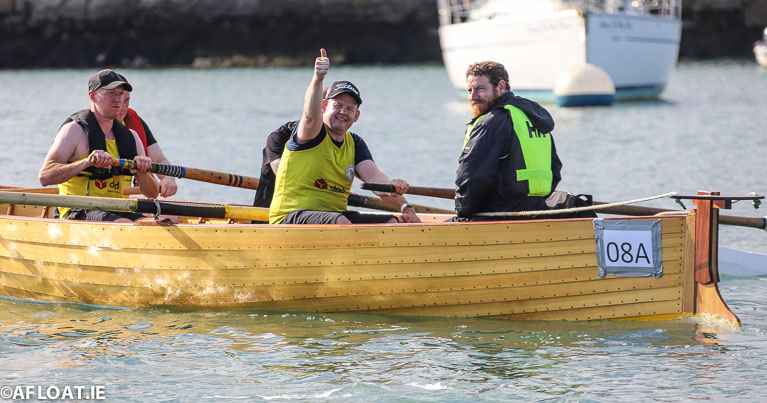

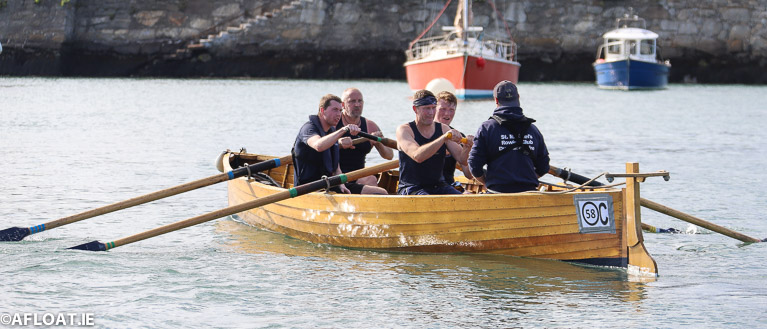
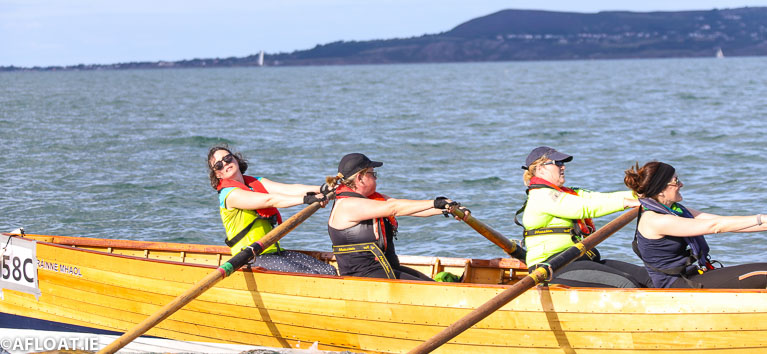
St. Michael’s Rowing Club will host The Hobblers Challenge on the 7th of September. The challenge is a 28km endurance coastal rowing race, which has been taking place since the 1990s on Dublin Bay.
Several courses have been used, predominantly from Dún Laoghaire Harbour to the Kish Lighthouse and back.
Four categories will compete this year: Ladies, Men, Mixed and Under 21.
The current course, set in 2017, starts at Dun Laoghaire Harbour, at the East Breakwater beneath the Hobblers Memorial, out the harbour mouth, around the landward side of a ‘gate boat’ off Merrion Strand, around Poolbeg Lighthouse, up the Liffey as far as the ESB towers, before doubling back, across the mouth of Dun Laoghaire Harbour, across Scotsman’s Bay, past Sandycove and Bullock Harbours, turning at Coliemore Harbour, before returning to Dun Laoghaire Harbour, finishing at the end of the East Breakwater.
“We are delighted to host this endurance race again. Similar to previous years, the competition is open for traditional skiffs so we are hoping to get as many East Coast rowing clubs taking part as possible,” said James Tedd, St. Michael’s Club Chairperson and race organiser.
Participants can choose between four categories: Ladies, Men, Mixed and Under21. “The latter two are an addition to the 2018 race,” explained Eoin Clarke, Race Registration Officer. “ We aim to be inclusive to experienced rowers of all ages, and we hope that, by introducing the Under21 category, we can help young rowers who transition from the youth level to the adult one get a taste for what endurance racing is, by competing against rowers of the same age. ”
The best times to complete the challenge are 2h47min - a record held by the St. Michaels’ men 2018, and 3h 3min - a record held by the St. Michaels’ ladies. Both records were set in 2018.




























